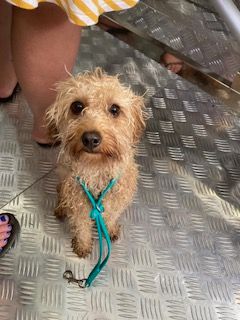Benefits and Importance of Regular Pet Grooming: Dog Health
As a dog owner, you want your furry friend to be healthy and happy. One of the easiest ways to achieve this is through regular grooming sessions. Grooming is not just about making your dog look good; it’s also about maintaining their overall health and well-being.
Let’s explore the benefits of dog grooming, from keeping their coat shiny and healthy to bonding with your pet through grooming sessions. Finding the right grooming products for your pet is just as important and the grooming (the old sunlight soap will just not cut it anymore) so that you can provide them with the love and care they deserve.

Grooming, Essential or Not For Your Dog’s Health
Here at Farmer Pete’s grooming we have done the research for you on how
essential regular dog grooming is for maintaining your pet’s happiness and health.
Coat and skin health
Regular grooming plays a vital role in maintaining the overall health of your dog's coat and skin. Brushing your dog's coat helps remove dirt, debris, and loose hair. This prevents tangles and matting. Mats can be uncomfortable and restrict proper airflow to the skin, leading to skin irritation, hot spots, and potential infections.
Brushing also stimulates the production of natural oils in the skin, which helps keep the coat moisturised, reduces dryness, and enhances its natural shine and reducing the risk of dryness or flakiness. A healthy coat regulates body temperature and protects your dog from environmental elements.
Reduces shedding
Shedding is a common occurrence in many dog breeds. Regular grooming, especially brushing, helps to control and manage shedding. By removing loose hair through brushing, you can significantly reduce the amount of hair that ends up on your furniture, floors, and clothing. This is particularly beneficial for individuals who may have allergies or sensitivities to pet dander, as it helps keep the environment cleaner and minimises potential allergic reactions.
Prevents matting and discomfort: Mats are tangles that form in your dog's coat when dead hair, dirt, and debris become tangled and compacted and forms tight knots. Dogs with long or curly hair are prone to matting. These mats can be painful for your dog, as they pull on the skin and can lead to skin irritation, sores, and even infections as they restrict your dog’s movement.
Regular brushing and combing help to prevent matting by removing loose hairs and preventing them from interweaving. By keeping your dog's coat tangle-free, you ensure their comfort and prevent the need for more extensive grooming procedures that may cause stress or discomfort and you contribute to their overall comfort and well-being.
Nail and paw care
Regular grooming includes nail trimming, which is essential for your dog's comfort and mobility. Overgrown nails can cause pain and discomfort when walking or running, potentially leading to gait abnormalities or joint issues.
Regularly trimming your dog's nails keeps them at an appropriate length and reduces the risk of them getting caught or broken. Make sure you check the dew claws too as these can cause problems if they get too long, including injuring the pad if they curl around and into the tissue of the pad and are at risk of being damaged if they get too long.
Dew claws are not worn down by exercise and may need trimming more often than the nails on your dog’s toes. Grooming also involves inspecting and caring for your dog's paws, such as checking for cuts, foreign objects, or signs of infection. By maintaining healthy paws, you prevent discomfort and reduce the likelihood of developing more severe issues.
Ear and dental hygiene
Grooming sessions provide an opportunity to check and clean your dog's ears, promoting good ear hygiene. Dogs with long ears or those prone to ear infections benefit from regular ear cleaning to remove dirt, wax, and debris. By keeping the ears clean and dry, you reduce the risk of infections and discomfort. It also allows you to check for any signs of infection, inflammation, or parasites.
Additionally, dental hygiene is crucial for your dog's overall health. During grooming, you can examine your dog's teeth and gums, looking for signs of dental problems such as tartar build-up, gum inflammation, or tooth decay and take appropriate steps such as brushing their teeth or scheduling professional cleanings.
Regular brushing of your dog's teeth or scheduling professional cleanings helps prevent dental issues which can lead to pain and discomfort and of course, reduces expensive vet bills. It also maintains your best mates’ fresh breath. Now, if that’s not a good reason to maintain good dental hygiene I don’t know what is!
Bonding and socialisation
Grooming sessions offer a unique opportunity for you to bond with your dog. It's a time when you can focus solely on your pet, providing them with the attention and care and love they deserve.
By engaging in grooming activities, such as brushing, combing, and bathing, you strengthen the bond between you and your dog. It can be a positive and enjoyable experience for both of you, promoting trust, relaxation, and a sense of calm. Regular grooming also familiarises your dog with being handled, making future vet visits or grooming appointments less stressful.
Early detection of health issues
Regular grooming allows you to observe your dog closely and identify any physical changes or abnormalities early on. By routinely examining your dog's skin, coat, ears, eyes, and teeth, you become familiar with their normal appearance and condition.
This familiarity makes it easier to spot any deviations that may indicate underlying health issues. For example, you might notice changes in skin texture, lumps or bumps, redness or inflammation, discharge from the eyes or ears, or signs of dental problems.
Early detection of such issues allows you to seek veterinary care promptly, preventing further complications and improving the chances of successful treatment and ensuring your dog's well-being.

Finding the Right Grooming Products for Your Pet
Selecting the right grooming products for your furry companion is crucial to maintain their overall health and well-being. As a pet owner, it’s important to consider your dog’s coat type and texture while choosing grooming supplies.
Natural and non-toxic ingredients in grooming products can help avoid allergic reactions that could harm your pet. Additionally, choosing the right brushes, combs, and nail trimmers can make the grooming experience more comfortable for your furry friend.
Regular bathing with a suitable shampoo also helps keep your dog clean and fresh, ensuring they are happy and healthy. By selecting quality grooming products, you can ensure your pet looks and feels good, improving their overall happiness and quality of life.
If you are unsure what are the best products for your dog consult Farmer Pete’s Groomers, they will be able to help you decide.
When Is The Best Time To Start Grooming Your Dog?
Start grooming your dog as a puppy. Choose times when they are tired and less energetic. Limit your grooming sessions to a few minutes, as young pups have short attention spans. Talk in a reassuring manner and check their ears, teeth, paws, and nails.
Over time, your pet will become used to the grooming ritual and enjoy being handled and inspected. Offer them a tasty treat as a reward afterwards. Farmer Pete’s treats are always a welcomed reward by your pup and great for starting training too.
Dogs Who Do Not Like To Be Groomed
If your dog is anxious about being groomed, challenging to handle, or you just do not feel comfortable grooming, bathing, clipping, or trimming nails, using a professional groomer such as Farmer Pete’s grooming might be a good option. We are a trusted and reputable professional grooming service who uses gentle handling and rewards to help your pet feel comfortable.
How Often Should I Have My Dog Groomed?
The frequency of grooming your dog depends on a mix of variables, including breed, coat length and type, amount of time spent outside getting dirty, and climate. It also depends on how you ask a professional to groom your dog – a short puppy cut might mean a return trip isn’t required for several months – and whether you feel comfortable doing some touch-up grooming at home.
No matter whether you visit a professional with your dog every six weeks or three times a year, it’s best to do a little additional grooming at home. Cleaning teeth, trimming nails, brushing the coat, de-matting, monthly shampoos, checking ears, and freshening up private parts will make your furry friend more healthy, comfortable, and pleasant to live with.
For young puppies and dogs who have never been professionally groomed, you should take gentle and gradual steps to handle and brush your dog, touch feet and nails and offer treats, and even try running an electric toothbrush around the coat for dogs that will need to be clipped.
Grooming is a bonding experience for you and your dog and will make the process more pleasant for the long run.

Things To Remember When Hiring A Pet Groomer
The specific grooming needs of dogs can vary based on factors such as breed, coat type, and individual characteristics. Some breeds require more frequent grooming, such as those with long or curly hair, while others may need less grooming maintenance.
It's important to consult with a professional groomer or your veterinarian to determine the appropriate grooming routine for your dog, taking into consideration their specific needs and requirements.
Quick Links
Contact Information
Grooming Hours
- Mon, Tue, Thu, Fri
- -
- Wednesday
- Closed
- Sat - Sun
- Closed
Sign Up and Save
Join the Newsletter
We will get back to you as soon as possible
Please try again later
All Rights Reserved | Farmer Pete's
Website by Social Space
